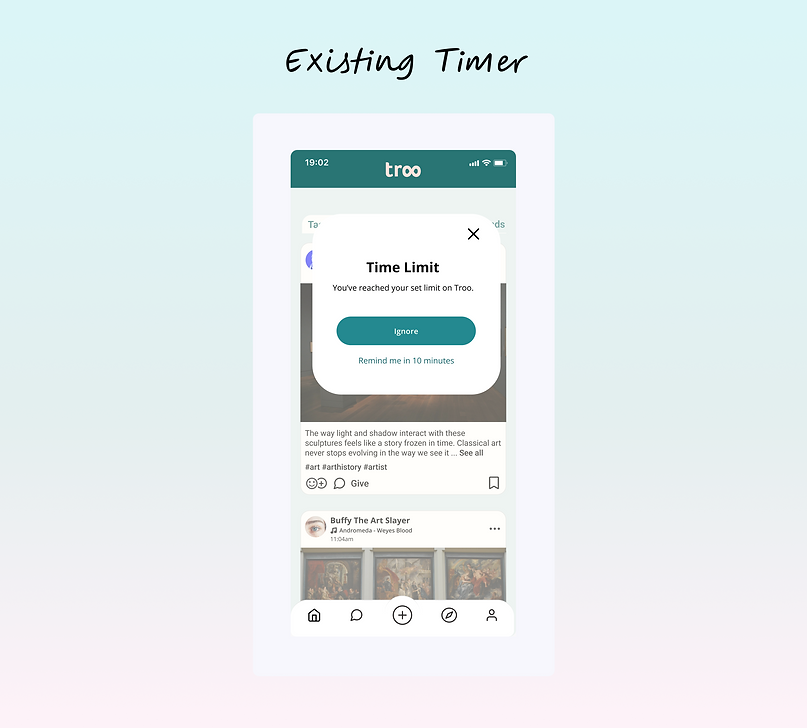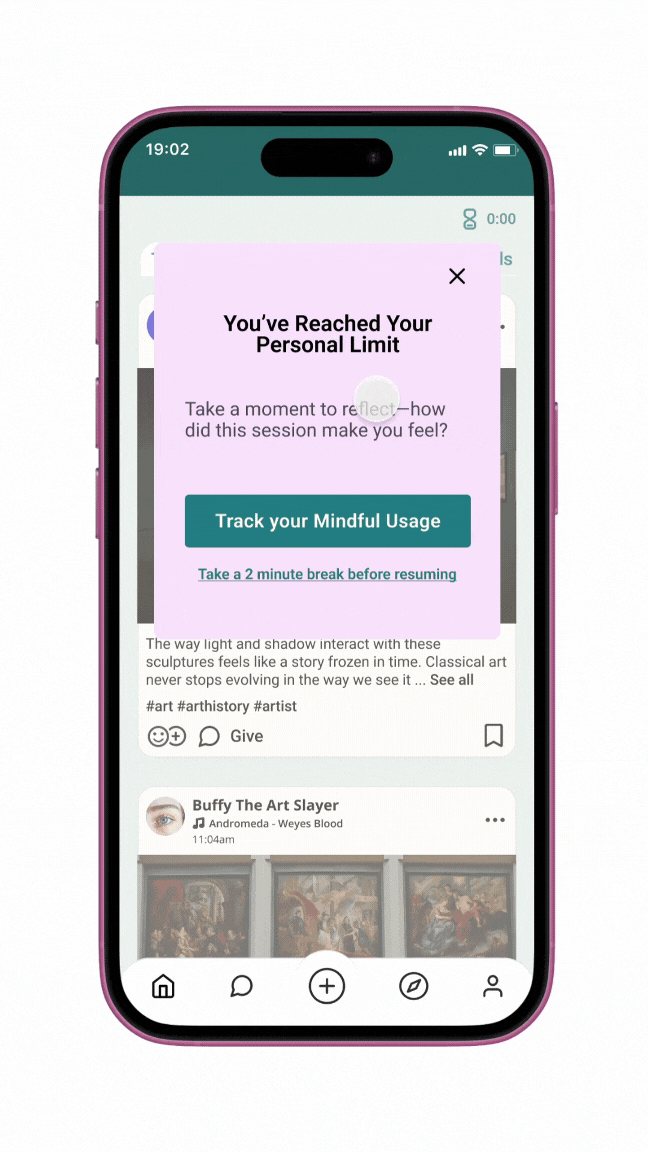
Evolving the Timer: Designing a Dashboard for Mindful Social Media Use
Role: Product Designer
Team: Senior Design Manager, Front End Developer
Tools: Figma, Pendo
Timeline: 40 hours
Process: Research, design, ideation, prototyping, testing

Overview
I redesigned the existing anti-doomscrolling timer to evolve into a holistic digital well-being system, providing users with greater control over their social media habits.
While the original feature helped limit excessive scrolling, data showed that users often ignored reminders or set limits but still returned quickly. To encourage mindful engagement, we introduced custom session limits, mindful break prompts, and a well-being dashboard that gives users insights into their scrolling behavior.
By improving this system, we not only helped users break unhealthy habits but also positioned our platform as a leader in ethical social media design.
What Is Troo?
Troo is a social media platform designed to foster authentic, ethical, and meaningful interactions. Unlike traditional social media that thrives on maximizing screen time, Troo prioritizes user well-being, offering tools that encourage balance and mindful engagement.
By expanding the anti-doomscrolling feature, we empowered users to take control of their social media habits—instead of letting their habits control them.
An ethical social media app focused on meaningful connections and keeping data private
Who We Are Solving For
Studies show that excessive social media consumption can lead to increased anxiety, reduced focus, and disrupted sleep patterns.
We identified two primary user groups who would benefit most from a more comprehensive well-being system:
-
Mindful Users – Users already setting time limits but needing better tools to stick to them.
-
Compulsive Scrollers – Users who recognize their excessive use but need gentle nudges and insights to change their habits.
Both groups needed a more intuitive, flexible, and engaging way to regulate their time on Troo without feeling forced into quitting.
Many users love staying connected on social media but struggle with unintentional overuse.
The Problem
Users were ignoring time limits, leading to ineffective habit changes.
Through Pendo analytics and user feedback, we found that 35% of users bypassed the timer by selecting "Remind me in 10 minutes" multiple times, and 22% turned the feature off entirely after initial use. This indicated that rigid time limits alone weren’t enough to encourage real behavior change.
Users needed a more adaptive, supportive, and engaging system—not just a simple lockout feature. The challenge was to enhance the anti-doomscrolling system while keeping it user-friendly and non-restrictive.
The Process
Exploring more than just the timer
I explored different ways to encourage healthier scrolling habits while still maintaining user freedom. The solution needed to be customizable so users could tailor limits to their needs, encouraging with positive reinforcement instead of harsh restrictions, and insightful by helping users understand their scrolling patterns without judgment.
The Exisiting Timer
The original design featured:
-
A set time limit users could adjust.
-
A pop-up alert when the limit was reached.
-
Two options: Ignore or "Remind me in 10 minutes."
Problems Identified:
-
Many users ignored or postponed the reminders multiple times.
-
Lack of post-session insights on how time was spent.
-
No progress tracking to encourage habit-building.

Encouraging mindful breaks
I redesigned the timer modal to shift from a strict limit to a mindful reflection moment. Instead of a hard stop, users now see a gentle prompt asking how their session made them feel. They’re encouraged to track their usage or take a short break before resuming.
What I learned:
-
42% of users engaged with the reflection prompt, while 58% skipped through without reading.
-
Users were more likely to engage when the prompt included a clear action (e.g., “Track your usage” or “Take a break”) rather than just a question.

Introducing the Mindful Usage Dashboard
To help users build awareness around their screen time, I designed a dashboard that provides:
-
Total time spent and personal limits for balance.
-
Engagement breakdown to differentiate active vs. passive use.
-
Session tracking to bring awareness to app-opening habits.
-
Mood check-ins for self-reflection and mindful engagement.
What I learned:
-
40% of users checked their dashboard within the first week.
-
15% adjusted their session limits after reviewing their usage insights.
The Final Version
After multiple iterations, the final system includes custom session limits, reflection prompts before extending screen time, and personalized insights into user behavior. These updates empower users to make intentionall choices rather than enforcing rigid restrictions, fostering healthy digital habits in a supportive way.

Results
After launching the Mindful Usage Dashboard, engagement with time limits increased by 15% as users actively set personalized boundaries instead of dismissing alerts. 22% of users voluntarily reduced their session times after reviewing their insights, and positive sentiment increased by 35% in feedback surveys. These findings confirmed that offering insights and reflection prompts was more effective in promoting healthier digital habits than strict time restrictions.
Reflections
What I Learned:
-
Users engage more when given autonomy over their limits rather than imposed restrictions.
-
Actionable insights and reflection prompts drive better behavior change than simple alerts.
-
Seamlessly integrating well-being tools into the experience increases adoption and sustained use.
Next Steps:
-
Monitor engagement patterns to refine dashboard insights and prompts.
-
Expand tracking options to help users better understand their browsing vs. active engagement.
-
Explore deeper personalization to tailor recommendations based on user habits.
.png)